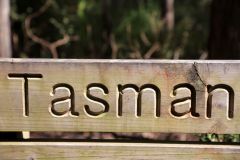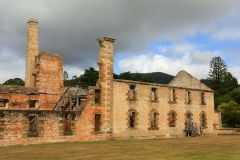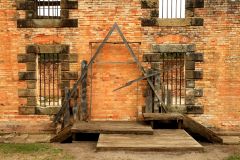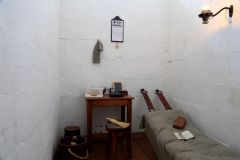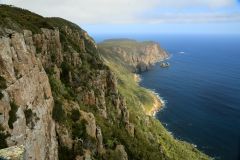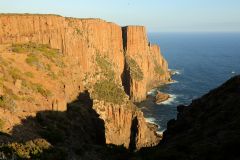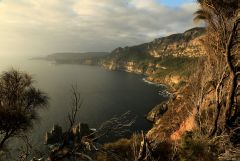Tasman Peninsula @ Tasmania
Down Under of Down Under: Tasmania. Part 3: Richmond, Port Arthur, Cape Raoul, hitchhiking. The southernmost point of The Odyssey
When I dropped Rodriguezes at the airport, I still had 3 hours until I had to return the van, so I looked at the map to find out if there was some nearby tourist attraction and decided to go to Richmond historical town. Another nice place with bunch of historical buildings, an arched bridge, a slowly flowing river and willows. Full of European charm again. Bit too artificial though.
After one or so peaceful hour in Richmond I returned near the airport, returned the van, packed my small backpack and raised a thumb.
Because I wanted to travel lightly, knowing that I will do some hiking and travel by thumb, and also because I was too cheap to buy a check-in luggage for the flight to/from Tasmania, all I had was my camera backpack. Half of the backpack was taken by my camera and lenses, the other half was cramped with the most essential clothes and survival stock of food. Due to extremely limited space for food that I had, I only packed a chocolate bar, a bag of mixed fruits, few muesli bars, some cheese, bit of salami and one can of beans and I planned to survive 2 days on this diet. I also could not bring a tent, so all I had was my sleeping bag and a mat. Luckily, it’s really warm these days in Tasmania.
It took me 10 hours to get from A to A. Through C and D and E. At 9:00am, me, Irene and Alex were in Port Arthur deciding whether to go in or not when we finally decided we wouldn’t, then we went to see some other places, I dropped them off, I went to Richmond, and hitch-hiked back to Port Arthur to arrive thered at 19:30. It took me 6 rides. It was so great to be hitch-hiking. I had almost forgotten how amazing it was to hitch hike. The uncertainty combined with patient waiting for a ride was rewarding, especially after I got into the countryside. It felt so right! Like from On The Road. I seriously need to hitch hike more often.
Obviously, I’m not the only one who thinks that Tasmania is more beautiful than the mainland, because out of those 6 people who gave me a ride, 5 of them moved here from the mainland, after they fell in love with Tasmania during vacation. It was interesting mix of people. A truck driver, a weirdo, a shop attendant, an artist, a physical education teacher, a teenage couple.
After arrival to Port Arthur I looked for a sheltered place where I could spend a night. It was about to rain, so I needed some piece of roof, but at the same time I had to be hidden, to avoid being kicked out by neighbors, rangers or police. Finally I found my Shangri-La under an overreaching roof of a public toilet of a picnic area :-) I slept outside of the toilet shed, pretty much next to a toilet and there was a space between the ground and the bottom end of the wall, so I was hardly separated from the toilet, but it wasn’t as smelly or as disgusting as it sounds :-) Night was OK, no rain, no cold, no spiders on my face or in my sleeping bag. The only interruption was some silly wallaby jumping all around and making noises.
Early morning I left my neat Hotel Hilton and went straight to the visitor center of Port Arthur, which didn’t open for one more hour and then spent 5 hours in Port Arthur.
Port Arthur is the most famous and the most preserved former convict sites in Australia. Back in 18th and 19th century when Great Britain decided to populate the newly found continent Australia with convicts, Port Arthur served as a second level penal colony. The basic outline was this: if you committed crime in Great Britain, which was serious enough for transportation to a convict colony, you were sent to one of the convict colonies in Australia. If you committed further crimes there while serving your sentence, you were sent to Van Diemen’s Land (former name of Tasmania), to Port Arthur. As such, Port Arthur was filled by the worst criminals in British Empire, and had the worst punishments. As creme de la creme of penal colonies, it was the most feared destination in Australia.
Port Arthur started as a small penal colony, but soon (mostly due to closing of other second level colonies) became a large colony and was inhabited not only by prisoners but all sorts of other folks. The prisoners were used as free labor force, and so Port Arthur soon produced large quantities of timber, whaling ships and other vessels, shoes, clothes and other goods. Such a good economic model! :-)
After the policy of convict transportation was abandoned by the British, the convict colony turned into a normal town, but deprived of the former free labor force it went into decline and was abandoned soon after. Years later, fires destroyed most of it, and the site was decaying until Australia recognized it as an important part of its history and turned the former colony into historic site and tourist attraction. Nowadays it is bunch of ruined red-pinkish brick buildings, spread around a marvelous park. The ruins of the buildings themselves, as nice as they are, are not very impressive for us the Europeans. It’s not like ruins of thousand year old castle, or a great baroque palace. It’s bunch of English style buildings, less than 200 years old. It was for this reason that Irene and Alex finally didn’t want to spend the money on entry tickets, because we had just little time and we wouldn’t have the opportunity to “study” the place, and seeing the ruins themselves would not be very interesting. They were right. The key to seeing that place was having the time to wander around, soak up the atmosphere and read the stories behind it. It was this metaphysics of the place that made it such a worthwhile trip for me. First of all: the location is truly grand. A green park, trees and flowers imported from Europe, cold calm sea all around. As the guide on a short guided tour told us, the place hardly looks like a penal colony, because there is no fence around it, and there has never been one. Impossibility to escape was guaranteed by its natural setting. Port Arthur is located on Tasman Peninsula, which is connected with rest of Tasmania only by a narrow isthmus which is 100m wide. These 100 meters were well guarded by soldiers and ferocious dogs. No one ever escaped this way. The convicts could escape deeper into Tasman peninsula, only to find them surrounded by towering cliffs surrounded by cold wild Southern Ocean. Basically by escaping one condemned himself to death by starvation, drowning or freezing. Most of those who escaped and were not caught by the soldiers soon returned themselves to the colony to face frightening punishment, rather than solitary death high on the cliffs.
Few prisoners managed to escape by seizing a ship and sailing away, but most of them were caught and returned to Port Arthur.
The most interesting part of Port Arthur was pioneering concepts in industry of crime punishment. It was here that the first juvenile prison in British Empire was established, but more importantly, Port Arthur was experimenting ground for shifting philosophy of punishment from physical to psychological. Good old flogging was always at hand here, but additionally new forms of solitary imprisonment were introduced. “The Separate Prison”, tucked away from the main prison was the place. Small cells with only one prisoner, absolute silence (talking was prohibited, guards used sign language and even wore layer of soft material on their soles, so that their walking wouldn’t make sound), only 1 hour a day outside the cell dedicated to solitary exercise in a large cage. Every time the prisoners would walk out of their cells they had to wear face masks to cover their faces, and they were never addressed by their names, only by the number of their cells. This was to push the denial of their identity to the limit. And the prison’s pride and joy was “Punishment cell”. Cell roughly 2m x 1,5m was completely lightproof and soundproof. Those of you who have seen Shawshank Redemption have an idea of how it looked like. Days and weeks, spent in complete isolation, darkness and silence. I went into the cell and closed the door, and the first thing that came to my mind was: this would be a great place for a meditation retreat! Indeed, I think that Buddhist and Hindu monks would truly love this place. Unfortunately, I guess that few prisoners who were sent here used the time for attaining enlightenment through an uninterrupted meditation, and instead of it they went crazy. One English writer who visited Van Diemen’s land wrote: “Devil walked through Hobart and he was pleased, for he found hint for improving cells in hell”. On the other hand, those prisoners who behaved well, had the chance to go to school and learn a trade while in the prison and so after their release they had better chances to find a job and stay away from crime. “The machine for grinding criminals into honest man” – that was the motto of Port Arthur’s penal colony.
What shocked me most, was the crimes for which the convicts where transported to Australia. I always imagined murderers, rapists and other violent men. Instead, I found this on the file:
“John Smith, 9 years old, sentenced to 7 years transportation for stealing a handkerchief”
“John Doe, 16 years old, sentenced to 14 years transportation for stealing a pair of boots”
Etc.
7 years for stealing a handkerchief? WHAT THE FUCK?!?!?!
When I inquired about it, one of the guides told me that in most cases, these were not the first crimes of those people. So the guy who stole a handkerchief, probably stole couple of things before, was sentenced couple of times, and then when he stole the handkerchief the judge grew out of patience and sent him to hell, sorry, to Australia. She told me that the only people who were transported straight away after their first crime were women, because they needed women in Australia. Smart!
After thorough sightseeing in Port Arthur I hitchhiked to a trailhead of hike to Cape Raoul, and hiked, what a surprise, to Cape Raoul. It was already late afternoon and I was the only one doing the 5 hours long hike (shortly after start I met 4 people on their way back and that was it), so I had all the scenery for myself. And what a scenery it was! After 1 hour of ascent through a thick forest I emerged on a 300m high cliff with absolutely breathtaking view of cliffs soaring from the ocean. And the views once I reached Cape Raoul! I wish that the photos could fully convey the feeling, but they cannot. I’ve seen a cliff or two in my life, but these in Tasmania really impressed me! I love cliffs. I feel divine connection every time I’m watching the waves pounding those towers of stone. With no human being in sight, I could almost feel how Abel Tasman must have felt when he became the first European to visit this part of the planet.
Unless I go to the very south of New Zealand or to Chile/Argentina (or back to Tasmania and walk to Southeast Cape), this is the southernmost point of my journey.
Amazing place.
I was tempted to sleep up on the cliffs, alone with the gods, but this is Tasmania, weather changes quickly and clouds started to gather. And next day I had to hitchhike to the airport to catch my flight, and it was long way to the main road and so I decided to head back. I made it out of forest literally 5 minutes before everything turned completely black. There at the trailhead, there was “camping” sign, but in reality it was just a piece of field belonging to some local farmer, who named it camping. The only persons camping there were a stoned old hippie and his girlfriend. But there was no roof or any shelter, and so I went to the house of the farmer, to ask him if I can, for those 5 dollars that he asked as the camping fee, sleep outside his house under the overreaching piece of roof. When I knocked on his door and I told him I have no tent, he interrupted me:
“Oh, you are the guy who hitchhiked here and who started late afternoon and went to camp without equipment!”
“How do you know?” I asked
“The lady who gave you a ride, crashed her car”
What??? Oh my god, I was sooooo sorry! The point is that the trailhead lies 10km down a dirt road. The lady who gave me ride from Port Arthur made this 10km detour from the main road, just to be nice and drop me off where I was going, even if it meant 10km there and back for her. And on her way back, she crashed her car. Poor woman! Where is good karma? Krishna are you sleeping or what? Fuck!
Well she didn’t destroy the car, just damaged something and so this guy helped her to get her on the main road.
And then, this guy said:
“You know what, come and sleep inside, I have a bed”.
His house was a to-be guesthouse. He had been building it for 8 years and it was close to completion, and so one of the rooms already had a bed and a working sink and toilet, and so he let me sleep in this room for 5 dollars. The deal of the year! 5 bucks for a private room in Australia! :-)
Next day I hitchhiked back to the airport, and after 6 rides I made it there, 3 hours before the departure. The best part of my journey to the airport was when I was hitchhiking where that dirt road meets the main road and as I lit me a cigarette I noticed a huge blackberry bush behind me and for 30 minutes I feasted on good old European blackberries. Yummy!
So long Tasmania. I liked it a lot. Caribbean, rural Europe and Australia all rolled in one. If only the water was warmer :-)
